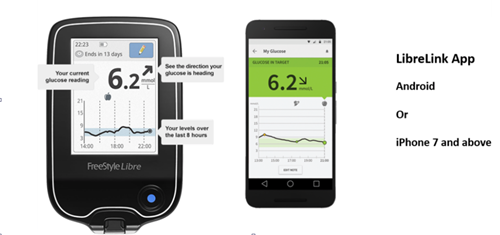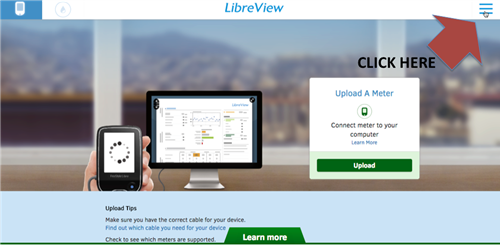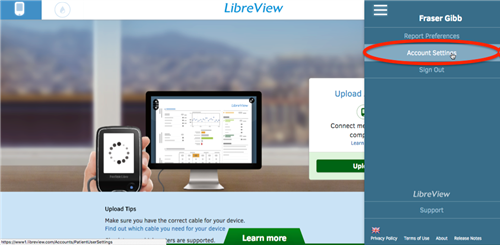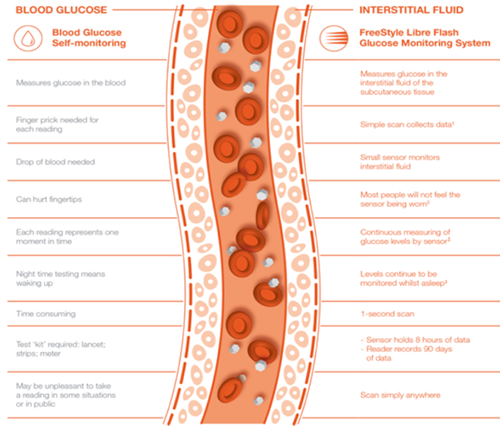Freestyle Libre
What is Flash Glucose Monitoring?
Flash Glucose Monitoring enables you to test your glucose levels without routine pricking your finger. The small sensor automatically measures and continuously stores glucose readings day and night.
The difference between blood glucose and sensor glucose
Unlike current blood glucose metres, the Freestyle Libre sensor measures the glucose in the body's interstitial fluid.
Finger prick blood glucose readings and sensor glucose reading won't always match and in fact are likely to be different. That's because sensor glucose readings come from the interstitial fluid (ISF), a thin layer of fluid that surrounds the cells of the tissues below your skin, not from your blood. There is a 5 to 10 minute delay in ISF glucose response to changes in blood glucose. Glucose readings on ISF have been proven to reliably reflect glucose levels.
Freestyle Libre key points
- Simply insert a new sensor into the upper arm every 14 days
- Scan the sensor to obtain glucose values, no lancets required
- The sensor is water resistant in up to 1 metre (3 feet) of water for a max of 30 minutes
- There will be a 60 minute warm up period after applying the sensor
- Libre should not be used above 10,000 feet
- The reader can capture data from the sensor when it is within 1 cm to 4 cm of the sensor
- For a complete glycaemic picture (to ensure all the data is transferred from you sensor), scan at least once every 8 hours. Most people will want to scan more often anyway- at least 6 times a day is recommended.
Prior to attending Freestyle Libre education session you should where possible complete the Libre Academy which you can access through the Freestyle Libre website.
Driving and Freestyle Libre/CGM
In February 2019 the DVLA approved Flash and continuous glucose monitoring devices as a legitimate way for insulin-dependent drivers to monitor glucose readings. Previously drivers had to check their glucose levels with a finger prick blood reading no more than two hours before driving and then again on a break after every two hours of driving.
This updated guidance applies to car and motorcycle drivers who treat their diabetes with insulin, but for bus and lorry drivers the guidance has not changed and they will still need to do finger prick blood glucose readings.
Drivers that are using Flash and CGM devices must still confirm their blood glucose level with a finger prick test if:
- Their glucose level is 4 mmol/l or below
- They experience symptoms of hypoglycaemia
- The glucose monitoring system gives a reading that is not consistent with the symptoms they are experiencing (for example, they feel the symptoms of hypoglycaemia but the reading does not indicate this)
To read further about this updated guidance regarding driving with Flash and continuous glucose monitoring devices click here.
Freestyle libre app
The FreeStyle LibreLink app is compatible with NFC-enabled smartphones running Android OS 5.0 or higher and with iPhone 7 and higher, running OS 11 and higher. To use the FreeStyle LibreLink it requires registration with LibreView. You can then scan the sensor by using the app on your smartphone to monitor glucose levels. If you are attending a Libre education session then you may want to download the app prior to attending your session.
You can also download the LibreLinkUp app which allows you to share glucose readings with family, friends and healthcare professionals. This means they can:
- Remotely monitor your glucose readings and trends
- Receive updates when your glucose readings are too high or low
- Stay connected to help you manage your diabetes
What does the Freestyle Libre tell you?
- Current glucose reading
- Latest 8 hours of continuous glucose data
- Trend arrows showing if glucose levels are going up or down or changing slowly
- You can set your own reminders, alerts and add notes
- Range of reports to allow you to interpret your data and help make more informed management decisions

How often to scan?
- Minimum 6 per day; pre-meal, pre-bed, exercise
- If you think you are having a hypo or are at risk of a hypo
- Scanning after eating certain foods gives you a better understanding of how they affect your blood glucose levels
- Frequent scanning has been shown to improve HbA1c levels
Freestyle Libre starting checklist
- If appropriate to your diabetes centre, hand in the GP letter for Libre sensors to be added to your repeat prescriptions (some centres send letters direct to your GP)
- Look at the Freestyle Libre Academy and other educational materials
- Download Libreview/LibreLink app on your phone. You can share your data with your health professionals by entering your clinic ID (step by step instructions for doing this are below)
- Only correct your insulin dose at meal times unless ketones are present
- Don't be too reactive, remember you will be scanning post meals too
- Take your time and use the data to look for patterns
- When adding Libre settings into your reader and phone app - blood glucose targets for reports should be 5 - 9mmol/l to allow for post meal readings
Understanding trend arrows
If the trend arrow is straight up or down, check your blood glucose levels. You can then use the blood glucose result to calculate the insulin dose.
| Arrow trend before meal time bolus | Description | What this means | Action needed |
 |
Glucose is rising quickly (more than 0.1 mmol/l per minute) | 1 - 1.5 mmol/l in 10 - 15 minutes | Add 20% of meal time dose as extra |
 |
Glucose is rising (between 0.06 - 0.1 mmol/l per minute) | 0.6 - 0.9 mmol/l in 10 - 15 minutes | Add 10% of meal time dose as extra |
 |
Glucose is changing slowly (less than 0.06 - 0.1 mmol/l per minute) | 0.6 - 0.9 mmol/l in 10 - 15 minutes | Give usual meal time dose |
 |
Glucose is falling (between 0.06 - 0.1 mmol/l per minute) | 0.6 - 0.9 mmol/l in 10 - 15 minutes | Take 10% off meal time dose |
 |
Glucose is falling quickly (more than 0.1 mmol/l per minute) | 1 - 1.5 mmol/l in 10 - 15 minutes | Take 20& off meal time dose |
How to link your Libre account to your diabetes clinic
1. Log in to libreview.com using your login and password (same as for the Librelink phone app). Click at the top right corner to
open up the menu.

2. Click 'Account Settings'.

3. Click the 'My Practices' tab at the top of the page. Type you own clinic ID in the box and click add - you will receive confirmation
that you have added our clinic as your practice. You are able to remove this link at any time.

Wearing your Freestyle Libre sensor
The Freestyle Libre sensor is designed to be work for up to 14 days.
Sensor wearing tips
- Be careful about bumping into objects: Avoid bumping or catching your sensor on door frames, car doors, furniture, people, pets or other hard objects.
- Touching the sensor adhesive: Avoid touching, pushing or pulling on the sensor. Also you should avoid touching, scratching or pulling on the adhesive around the sensor, even if the adhesive has begun to peel.
- Getting dressed: Use extra care to avoid hitting or catching the sensor on clothing while getting dressed. Avoid wearing tight clothing on your arms as doing so may pull off the sensor.
- Showering/bathing: The sensor is water resistant but use extra care when cleansing around the sensor and when towelling off so that you do not catch or pull off the sensor. Do NOT take your sensor into water deeper than 1 metre (3 feet) or keep it immersed for longer than 30 minutes.
- Contact sports: Avoid contact sports and heavy exercise with activity that may knock off your sensor.
Skin preparation
Select an area of skin on the back of your upper arm that generally stays flat during normal daily activities (no bending or folding). Choose a site that is at least 2.5cm (1 inch) away from an insulin injection site. To prevent discomfort or skin irritation, you should select a different site other than the one most recently used.
| Situation | Solution |
| Oily surface | |
| Soap, lotion, shampoo or conditioner might leave oily residue on your skin that may prevent the sensor from sticking problem | To improve adhesion, clean your skin with soap and water, dry the skin, clean your skin with an alcohol wipe and allow the skin to air dry (do not blow on it) before proceeding |
| Wet surface | |
| Moisture gets in the way of adhesion. Keep your skin dry prior to application |
To improve adhesion, dry the skin, clean your skin with an alcohol wipe and allow skin to air dry (do not blow on it) before proceeding |
| Hairy surface | |
| Hair gets in between the skin and sensor adhesive | The site selected on the back of your upper arm should be clean-shaven |
Sensor adhesion
You might find it helpful to use the following products to support adhesion. Everyone's skin is different so you may need to find the one that is right for you.
| Product | Description |
| Torbot Skin Tac™ | A hypo-allergenic and latex-free “tacky” skin barrier |
| SKIN-PREP™ Protective Barrier Wipe | Protective liquid dressing that allows skin to breathe so tapes and films adhere better |
| Mastisol® Liquid Adhesive |
Clear, non-irritating, non-water-soluble liquid adhesive that secures dressings even in moist areas |
Sensor removal
If there is any residue adhesive left on your skin after removing the sensor then the following products have been found to help.
|
Product |
Description |
|
Baby oil |
Soft moisturiser |
|
Remove™ Adhesive Remover |
Removes adhesive residue on skin |
|
UNI-SOLVE™ Adhesive Remover |
Formulated to reduce adhesive trauma to the skin by thoroughly dissolving dressing tape and appliance adhesives. |
Libre and air travel
- The Freestyle Libre can be passed through airport metal detectors so you are okay to keep your sensor on while going through these.
- It should not be exposed to full-body scanners (i.e. x-ray or millimetre radio-wave).
- To avoid removing your Freestyle Libre sensor, you should request another type of screening to be performed by the security officer.
- If in doubt about the type of security scan you are passing through, notify the security officer prior to proceeding through the airport security checkpoint.
- Remember to bring medical evidence such as a letter from a medical practitioner, to confirm your medical device. Have this ready to show the security officer.
Any problems?
If you are having technical problems with your Libre (sensors falling off early/inaccurate sensors etc.) please contact Abbott customer care: 0800 170 1177 as your GP or diabetes care team cannot help with these matters.
